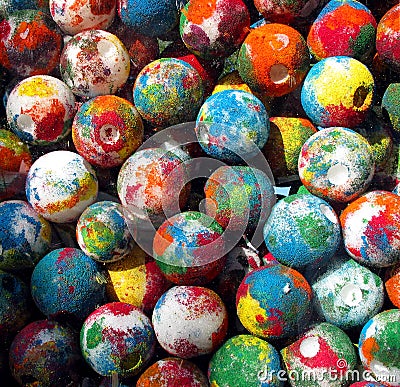When heading to the park for a play date, Bee wanted to take her bouncy balls to show her friend A. She seems to be really into them at the moment. To extend her learning and follow her interests, I also had the idea to take along some paint and paper and try a bit of bouncy ball painting. The park was the best place for this activity as we had enough space to really bounce the paint covered ball on the paper... and it meant less cleaning up at home, double bonus!

Who can play?
This activity is aimed at children aged 3 years and over, however all activities depend on the child's age and stage of development. Younger children can play if the bouncy balls are substituted by larger balls.
What do you need?
- Bouncy balls
- Large roll of paper or unwanted wrapping paper
- Non toxic, waterproof paint
- Baby wipes to clean up afterwards
- Bowls to hold the paint and balls
- Clothing that you do not mind the children getting paint on
- Bag to place the items used to paint in
Safety:
Small bouncy balls can be swallowed, so ensure children are closely supervised. When carrying this activity out in the park, ensure that you have a good distance between yourself and other visitors, this will ensure that no one gets hit with a stray painted bouncy ball.
What did we do?
Prep the area, by placing the paper on the ground and paint in bowls. It was a little bit windy on the day we made our painting, so we had to add objects to the corners to keep the paper down. Baby wipes were placed right next to the activity to clean the children once they had finished the activity.
The children were then given a bouncy ball and I talked about how they could dip them in the paint and bounce them on the paper. A enjoyed bouncing hers from a low height and Bee preferred to bounce hers high. Both children found it funny when the ball bounced on and off the paper, making lots of splodges. A said the ball was "making tiny circles on the ground"
 |
| Paint covered bouncy balls in action |
 |
| Printing with the bouncy balls |
 |
| Bee experimenting with foot painting and saying hi to her shadow |
By the end of the activity, the children looked really mucky, but you could see that they had enjoyed the process of getting in that state!.
 |
| Paint covered children and Bee's new preferred pose |
Painting in the park was a big success. The children were given the experience to paint on a large scale and the bonus for me, was not having to wipe away paint from my walls and floor.
What did we learn?
- Communication and language-Talking about what they see and feel. Describing textures and what is happening.
- Physical development- Fine and large manipulative skills when throwing the bouncy ball on the paper and walking through the paint with their feet
- Personal, social and emotional- Making relationships, taking turns with the paint. Self help skills and asking others for help when the paint was getting slippy. Fun and enjoyment. Cooperation when creating a piece of art with their friend feelings and self help
- Literacy- Making marks with the paint
- Mathematics- Learning about the shapes the ball and their feet make on the paper. Developing an awareness of space and measurement when creating their masterpiece, for example, A bounced her ball low and Bee bounced her ball high.
- Understanding of the world- Developing an awareness of change of state, when the children mixed the paints together. Experimenting the effects that the paint covered ball has on the paper, when it bounces on it.
- Expressive arts and design- Mixing and experimenting with different coloured paints. Creating patterns with the paint, balls and feet
What could be done next?
- Use larger balls.
- Roll the balls rather than bounce
- Try this activity on a smaller scale, by placing paper on a tray and then rolling marbles coated in paint around on it.
No comments:
Post a Comment